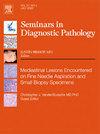The expanding family of ALK-rearranged Mesenchymal Neoplasms
IF 3.5
3区 医学
Q2 MEDICAL LABORATORY TECHNOLOGY
引用次数: 0
Abstract
The increasing use of next generation sequencing (NGS) technologies has resulted in a rapid increase in molecularly defined mesenchymal entities and enabled molecular characterization of existing phenotypically defined entities. These recent developments have expanded the clinicopathological spectrum of ALK-rearranged neoplasia, at same time highlighting a wide array of non-ALK fusions in many ALK immunoreactive neoplasms. This led to emergence of an “ALK vs. non-ALK fusion” concept among ALK immunoreactive neoplasms. The ALK fusion category includes morphologically defined entities (inflammatory myofibroblastic tumor and related neoplasms and epithelioid fibrous histiocytoma) as well as emerging fibro-/myxoid (“fibroblastic”) neoplasms of skin/ superficial soft tissue and vocal cords and ALK+ (mostly pediatric) histiocytoses. Lastly, diverse categories of unclassified ALK fusion neoplasms have been reported that display tyrosine kinase-like phenotype (CD34+/ S100+), foamy cell/ pseudolipogenic features and unclassified high-grade morphology. On the other hand, the “non-ALK fusion” category expands to include entities with regular/ frequent ALK reactivity (angiomatoid fibrous histiocytoma with EWSR1/FUS::CREB, spindle/ epithelioid cell rhabdomyosarcoma with EWSR1/FUS::TFCP2 and unclassified sarcomas with EWSR1/FUS::CREB fusions). The latter category has challenged the value of IHC and/ or FISH alone to confirm or rule out ALK alterations, underlining the pivotal role of NGS to verify the exact driver fusion. Under circumstances, identification of the exact fusion may have therapeutic and/ or prognostic implications. This overview discusses the main ALK fusion entities with emphasis on differential diagnosis.
alk重排间充质肿瘤的扩大家族。
随着下一代测序(NGS)技术的日益普及,分子间充质实体的数量迅速增加,并使现有表型定义实体的分子表征成为可能。这些最近的进展扩大了ALK重排瘤变的临床病理谱,同时强调了许多ALK免疫反应性肿瘤中广泛的非ALK融合。这导致在ALK免疫反应性肿瘤中出现了“ALK与非ALK融合”的概念。ALK融合类别包括形态学定义的实体(炎症性肌纤维母细胞瘤及相关肿瘤和上皮样纤维组织细胞瘤),以及皮肤/浅表软组织和声带新出现的纤维/黏液样(“纤维母细胞”)肿瘤和ALK+(主要是儿童)组织细胞增生。最后,不同类别的未分类ALK融合肿瘤已被报道显示酪氨酸激酶样表型(CD34+/ S100+),泡沫细胞/假脂质特征和未分类的高级别形态。另一方面,“非ALK融合”类别扩大到包括有规律/频繁ALK反应的实体(EWSR1/FUS::CREB的血管瘤样纤维组织细胞瘤,EWSR1/FUS::TFCP2的纺锤形/上皮样细胞rhabdomyosarcoma, EWSR1/FUS::CREB融合的未分类肉瘤)。后一种类型挑战了IHC和/或FISH单独确认或排除ALK改变的价值,强调了NGS在验证确切驱动融合方面的关键作用。在某些情况下,确定确切的融合可能具有治疗和/或预后意义。这篇综述讨论了主要的ALK融合实体,重点是鉴别诊断。
本文章由计算机程序翻译,如有差异,请以英文原文为准。
求助全文
约1分钟内获得全文
求助全文
来源期刊
CiteScore
4.80
自引率
0.00%
发文量
69
审稿时长
71 days
期刊介绍:
Each issue of Seminars in Diagnostic Pathology offers current, authoritative reviews of topics in diagnostic anatomic pathology. The Seminars is of interest to pathologists, clinical investigators and physicians in practice.

 求助内容:
求助内容: 应助结果提醒方式:
应助结果提醒方式:


